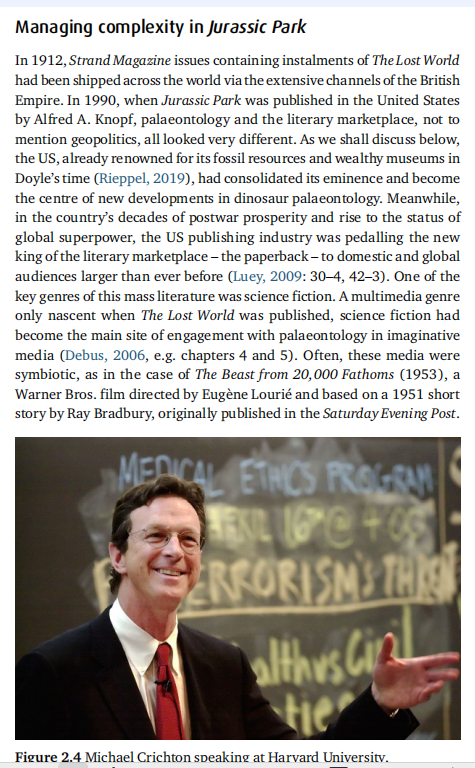
Prehistoric Enchantment of Twentieth Century: Popularizing Fairy Tales of Science: Dragons of Romance and Dinosaur Renaissance
Examine a close reading of Jurassic Park with textual references and critical perspectives.
“The Lost World: Jurassic Park” franchise by Michael Crichton is a novelization of Mary Shelley’s “Frankenstein Or The Modern Prometheus”. Michael Crichton’s masterpiece of the science fiction genre satirically critiques scientific and tech revolution, biological evolution, DNA research, paleontology and chaos theory. Modern filmic adaptation stages the mise en-scene and psychodrama of Jurassic Park: Fallen Kingdom and Jurassic World Dominion through animatronics and computer generated imagery. Isla Nublar conservatory is a themed park of cloned dinosaurs genetically engineered and genetically modified from the fossilized DNA by International Genetic Technologies Inc.
InGen. Mathematician Dr. Ian Malcolm and geneticist Dr. Henry Wu perform pharmaceutical experimentation upon these captured herds of dinosaurs in the setting of Isla Nublar in Jurassic Park: popular science fiction and lost world culture of the paleontological deep times. Extremely rare species are preserved in conservatory but nonetheless,these predators become a threat to visitors. We must embrace complexity theory and /or chaos theory to examine the aftershocks and aftermath of climate change exposing environmental managers of Yellowstone National Park. Medical doctor buttressing as a bestselling novelist to publicize paleontological paranormalism and spiritualism of evolution, dinosaurs and extinction to truly massive audiences. Satirical critiquing of hubris and corruption of industry and politics intricately foreshadows behind the scenes of verfremdungseffekt.
Western world industrialization, rationalization and global colonialism within the twentieth century have been sequestered of wonder and mystery, thus leaving a legacy of skeptical disenchantment. Language of myth, magic, romance, folklores and fairy tales are encapsulated in the engendering of dreams, visions and dantesque journeys, speculative illustrations through palentological-geological novels like “Jurassic Park” and “Lost World”. Even pure scientific discovery is an aggressive and penetrating act viscerally banishing equilibrium of flesh in the robotic cyborg posthuman. Protagonist paleontologist Dr. Alan Grant is gobsmacked with Ellie Sattler to discover prehistoric remains of atavistic beasts and meets John Hammond, the venture capitalist with growth potential in exchange for future profits founder of InGen and owner of Jurassic Park. Billionaire showman and pity bernam figure expostulates “That’s a terrible idea. A very poor use of new technology…helping mankind is a very risky business. Personally, I would never help mankind.”
John Hammond doesn’t feel humanitarian philanthropism and altruistic agency to cater for vaccination and immunization with bioengineering companies projects investments. His Visitor Center and Private Bungalow epitomizes eclecticism and eccentricities, while bereavement of fatalistic accidental death encounter epitomizes rationality of disaster from unemphatic corporate systems analyst. While strolling, the corporate magnate is flabbergasted by a tyrannosaurus roar (ironically defrauded of his own mischievous grandchildren’s recorder, he is fated to death trap by herd of Procompsognathus. Malcolm’s prognostication of awry of the genitalia female mutilation in the biological reserve.
Meanwhile computer scientist Dennis Nerdy unbeknownst to Malcolm smuggles dinosaurs embryos off the island and commits industrial espionage by infringing DNA samples to Biosyn because of his low salary and financial bankruptcy. Nerdy disables the park security system to pilfer the embryos initiating a cascade of failures disrupting electrical fences and what follows is a power outage stranding protagonists. Postpounding creepy sci-fi science outpacing morality, human beings fate, technocrats of nature or the nature’s apocalypse wrecking human survivalism exhorts human beings pantheism in exchange for fertility and bounty from mother nature Gaia.
With Wu’s assistance, John Hammond appropriates Jurassic Park to Modern Prometheus and Frankenstein, casting God to plague the world by unhindered and unregulated innovation is ripe for potential abuse and corruption; unless divination of celestial hierarchy intervenes the consequences of disastrous catastrophes imperils humankind. Icarus audacity of moira transgressing to critique insatiate profittering capitalism through central planning of greediness and recklessness embodied into economic rationalism associated with consumption and production. We should let nature take its course without coercion, curtailment, censureship and containment.
Soviet communists looking at death and despair all around them while Hammond is despotic and tyrannical to defend central planning policies and procedures to master nature. “You decide you will control nature”. “You are in deep trouble because you can’t do it. Here you have made systems which require you to do it. [..] ‘’there’s a sudden, radical and irrational change which is built into the very fabric of existence.” Hubristic and naive characters like Hammond, Hu and Arnold wish to enforce measures to protect endangered species and mitigate global warming contrasting pragmatists and realists Grant, Sattler and Malcolm.
Further Reading, References, Endnotes and Podcasts
Wikipedia readings
The Most Iconic Scenes from the Jurassic Park Movies | Movieclips
63.6M subscribers
JURASSIC PARK by Michael Crichton | Book Review
3.19K subscribers
Jurassic Park by Michael Crichton Book Review & Reaction | When Crichton Ruled The Earth
131K subscribers
UCL Press
Chapter Title: Arthur Conan Doyle, Michael Crichton, and the case of palaeontological
Fiction, Chapter Author(s): Richard Fallon and David Hone, Book Title: Palaeontology in Public, Book Subtitle: Popular science, lost creatures and deep time, Book Editor(s): Chris Manias, Published by: UCL Press. (2025)





